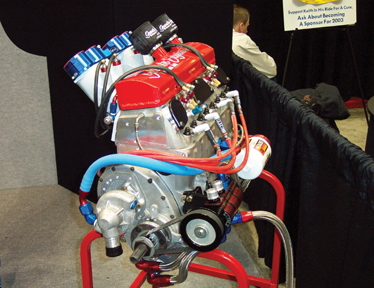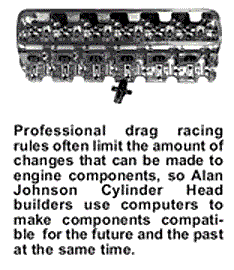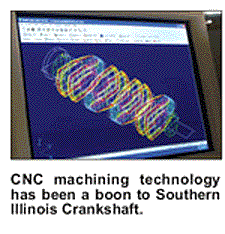It’s a simple process for those down in the trenches. An engine builder will make a phone call or click on a computer and within days, the latest parts show up at his shop, ready to be installed. But the traditional Stork method of delivery notwithstanding, exactly where do new engine parts actually come from? More accurately, how are they built?
We all know manufacturing methods are constantly changing so what super-trick means are builders using these days? That’s what we wanted to know so we asked a number of people in the industry to tell us how parts go from the computer to the shelf of your shop.
You don’t need to go very far back in time to see some of the latest methodology for building engines – race or street. But there’s an interesting correlation between how a factory uses street-based technology and building methods and how race engine tech and methods are employed.
When Dodge decided to get back into NASCAR with its aggressive 500 day program in 2001, of course a new engine was needed for NASCAR’s Cup Series (Dodge had gotten its feet wet in NASCAR’s Craftsman Truck Series by originally building new heads and intakes for what was effectively old short blocks). But if Mopar was going to run against GM and Ford’s latest equipment, a completely new engine was the price of admission. That’s exactly what was built.
In fact, the new Dodge powerplant was so new it was the first-ever NASCAR engine built just for racing. Most of the engines used at the time were variations of existing street engines. Even Chevy’s SB-2 was yet another twist on the venerable Small Block Chevy with what many called Ford-style heads on a 350 block with a couple of relocated head mounting holes.
Ford was also using street engines heavily modified for racing, mostly via the CNC-designed heads and intakes, this time mounted at a slightly different angle to raise and straighten the ports thereby increasing flow to the heads and making more power.
The Dodge R5-P7 (R5 block and P7 heads), as it would come to be known, took only nine months to yield the first test pieces. Street production design and building methods and rapid prototyping technologies such as Stereo Lithography and Layered Object Manufacturing (LOM) drastically cut design and prototype times. And these certainly weren’t your traditional prototypes. Dodge’s early evaluation models were not made of metal in a casting plant but made of paper via the LOM method. Layers of paper, .003" to .010" thick, made accurate and life-sized models in an office not a shop.

Another new computer technology called stereo lithography mapped the movement of all flows, such as water, fuel mix and oil throughout the engine thus saving countless man-hours determining the optimum flow through the heads and blocks. This computer modeling paid off the first time.
Normally hard to control on a race engine, water temperatures inside the new Dodge were within an incredible three degrees anywhere in the engine. Dodge’s use of graduated water manifolds was a patent pending idea. The process delivers fresh water via manifolds molded into the outside of the block with another under the intake that allow just what is needed for cooling each designated area.
With design procedure times drastically slashed, casting times also were put on a similar fast track. Usually taking 14-16 weeks, lead-time was crunched and teams produced the first cast parts in an astounding five weeks. Those pieces were tested and when needed, corrections were quickly made and a better version built. It took designers only four versions to get to the on-track test stage. By the time the R5 P7 actually raced, only one more evolution of the components had been added.
In yet another version of "from the street to the track," the Dodge R5 block included something else new to NASCAR. Dodge used the "open deck" block design seen in its production engines. Open deck blocks traditionally have the benefit of better block casting quality and more consistent bores – two more carryovers from production engines that proved beneficial to developing and building a race engine.
When Toyota came into NASCAR racing in the NASCAR Craftsman Truck Series in 2004, the engine design team followed Dodge’s lead and built their own racing versions of items such as fuel pump, power steering pump/reservoir, hoses and even the coolers for water and oil on the new Toyota Tundra V8. The basic premise was to make the driveline, and eventually the entire vehicle, a complete system of finely tuned components working together. To that end, Toyota Racing Development relied on their own components, mostly of billet design, for the obvious benefits.
But a company doesn’t have to be one of the biggies of the industry to find some speed in getting their parts out. World Products of Ronkonkoma, NY, is known for two big things: Monster Truck engines and a seemingly infinite number of cast iron or aluminum performance blocks and heads. Company designers are using the latest CAD/CAM technology and CNC machines to help make the tooling for patterns and molds. They now run their casting program about as fast as one of their 540 c.i.d. Monster Truck powerplants.
Company leader Bill Mitchell says the programs allow operators to build casting tools and effectively go right from CAD straight to tooling. "It’s what you call paperless machining," says Mitchell. "That’s how we build the tools to make the cast parts."
With today’s numbers-crunching computers and CAD/CAM programs making computers more accessible and affordable to smaller businesses, the use of technology is just plain smart. For the money required as little as a few years ago, computer buyers both in and out of the business world are getting more bang for their buck. The trend continues into the software needed to design parts and program machines to make those parts. Software has become more user friendly, effective (read that as faster) and even more affordable as competition rises.
The time involved in getting parts to market is dramatically reduced – in fact, Mitchell says the process saves a whopping 60 percent of the time normally used to make molds and patterns. "The tooling is the most lengthy process of the job. It used to take two and a half years to make a new casting. Now it takes, maybe, nine months."
The benefits of CNC machining aren’t always about faster ways of casting or getting to the casting stage as much as about getting the product to testing and then the market faster. The word billet may be thought of in some circles simply for "Bling Bling" car show accessories, but serious racing parts have been made on CNC machines for just as long.
Many consider it to be the best of both worlds. With new metals technologies, strength and durability are part of the new billet pieces, whether they are steel or aluminum. Billet is still growing but is here to stay.
The line between making a cast part and a billet part is getting blurrier all the time. The speed aspect of a CNC machine is superior to going the casting route. Parts manufacturers often have banks of CNC machines running all shifts to churn out parts faster than a casting plant. Often these parts are all but finished when they drop from the machine, creating yet another advantage over a raw, unfinished casting that will still need machine time to be market ready.

Mark Massey of Columbus Diesel Supply Company, Columbus, OH, points out that more and more billet parts are being made. Massey’s CDSC makes many of the serious tractor pulling parts for the rapidly growing diesel segment of the performance world. Massey says CNC and billet work can replace casting work in some areas because a mold doesn’t have to be created to make the initial product. That reduces turnaround time, which further reduces testing time.
Massey believes outsourcing is a key, especially when the small numbers of products for racing are compared to OEM production numbers. One example is the billet housings, which are made in only 20 lot runs. The same holds true for turbo exhaust housings.
Not only are the CNC pieces gaining in popularity, so are aluminum pieces in general. That’s not to say the company doesn’t use castings, but when it does, another outside source has to make those molds. CDSC will often make its own upgrades to the molds once the initial R&D work has been done and a direction for the piece decided. "A lot of this is reverse engineering," says Massey.

Massey also points out that coatings and automation are fringe areas of the production process that nonetheless factor in time. The coatings can make up for a metal’s shortcomings and add to service life. Putting the correct coating on a CNC piece can make it almost as durable as a cast piece, he says. As for automation, the same robots that make production numbers jump can also be used for more mundane jobs such as picking and handling parts as they are being created.
Another staunch supporter of CNC parts is Earl Gaerte, of Gaerte Engines, Rochester, IN. Known for his championship aluminum Sprint Car racing engines, Gaerte says most of what goes into a sprint car engine is CNC byproducts. Still, a few castings are still used, and for those, he employs mold and pattern designers and builders. Gaerte points out that fabricated sheetmetal pieces also factor into engines today, mostly for racing associations that allow them. Long seen in drag racing, fabricated intakes are now being seen in other racing circles. The advantage of quick production has to be a deciding factor for many.
LOM is becoming more popular – and continues to improve, Gaerte says, "The layered stuff is getting really popular with intake manifolds. It is not uncommon for the biggest players in racing to take a cast intake from design to bolt-on in as little as a week."
Gaerte says new and more versatile types of epoxy and resins are being used to create test pieces that are far more durable than paper versions. They can then undergo more rigorous testing, again reducing turnaround time of the component.
In the world of Top Fuel drag racing, it’s often a battle between the capabilities of new technology and some pretty tight reins. That’s because, according to Chris Barker of Alan Johnson Performance Engineering, Santa Maria, CA, the "basic architecture of the engine is dictated to us by the sanctioning body." Engine builders cannot change head or block designs, keeping them on a lifespan of two to three years. That reduces new product technology but keeps costs down – its intentional point by the governing bodies.
What Barker says happens at shops such as Alan Johnson’s is the tools promote speed and productivity. Most Top Fuel heads are made of 6013 aluminum and are billet in nature. They are created on computers using high end CAD/CAM software that is powerful enough to model the new cylinder heads to ensure they will work with other existing components. Barker points out the need to work with existing parts than with new ones: "We very seldom get to start with a clean sheet of paper."
It’s the same way with the company’s TFX billet blocks also used in Top Fuel racing. They start out as aluminum forgings with the same characteristics as 6061 grade. After some rough machining and heat treating, they are ready for a five-axis CNC machine with a spindle speed of 10,000 rpm rather than the older model’s 4,000-5,000 rpm. With feed rates to match, it isn’t long before that forging becomes a finished piece, ready to race.
Having the same piece made via the casting route not only takes more time but is more expensive too, Barker says. Patterns for blocks and heads more often run in the five digit range – and he reminds us they would still need to make a pass through the machine shop, too.
That same five-axis CNC is used on the heads for porting. But there, the human touch is more important – at least to establish baselines and foundations for the heads. Machinists will often shape the ports by hand and then digitize their work so they can reproduce it with a CNC program. Even then, teams will often "massage" the heads looking for that elusive "extra" horsepower.
The benefits of CNC machining don’t necessarily end at faster development and cheaper parts for your customers – as some engine builders have discovered, parts design and manufacturing can be a career-changing procedure.
Michael Schaefer, Southern Illinois Crankshaft, Red Bud, IL, says the implementation of parts machining has had a dramatic effect on his business model. "We’re still doing engine rebuilding, but for us, the progression is going toward us becoming a manufacturing company. Over the past couple of months, the majority of my business has been manufacturing crankshafts."
Schaefer says it all started back in the late 1990s, when the engine builder was building a reputation for making quality stroker crankshafts for tractor pulling motors. "We saw the fuel systems were getting better, the turbos were getting more efficient and the horsepower levels were increasing – they were creating horsepower levels that the normal factory stroker crankshaft could not handle. Even though we had a good business making stroker cranks, we saw the need for stronger crankshafts. We knew we had to expand and learned to machine a billet crankshaft utilizing CNC equipment."
Schaefer and his son began making crankshafts from billet steel around 2000 and today says his business is better than it’s ever been. "Our manufacturing has increased substantially over the past year. Our largest customer has requested additional machining time for the upcoming year."
Busy? Sure. Schaefer says he’ll probably have to add a second manufacturing shift to keep up with demand. But he cautions would-be manufacturers that there’s no guarantee of success.
"The world has become a smaller place. We now compete not only with machine shops in the nearby towns, but with the world’s markets. Understand that the job may go to China, and that you have to have a contingency plan when planning your business model," he says.
"I’ve been in business since the ’80s and I spent more on one piece of equipment on my business this past summer than I had since I started it," Schaefer explains. That one piece of equipment was a CNC machining center that took a great deal of soul-searching to purchase.
"One of the things you HAVE to remember is this," cautions Schaefer. "You have to run the numbers. When you start talking about doing those kinds of dollars, you need to make a decision from a purely business standpoint. You can’t be emotional about it. It has to be all about the numbers. And you’ve got to have numbers you can trust. We begin with our own in-house projections and back them up with outside professionals," Schaefer says.
Skilled manpower is also needed to learn and operate major CNC equipment. You have to have the ability and the time to learn programming.
In addition, suggests Schaefer, a former Engine Builders Association (AERA) chairman, "You’ve got to recognize opportunities, and be prepared to react."
Unfortunately, he’ll admit, not every reaction is a good one. "You don’t always win. There are things we’ve tried that did not work so well."
Still, business is booming for Southern Illinois Crankshaft, but it doesn’t simply revolve around tractor pulling crankshafts anymore. "No, we’re doing prototypes of crankshafts, some of which are quite unique. There’s some really neat stuff being developed and we’re just excited to be part of it."













